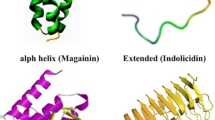Abstract
Plectasin is a defensin-like antimicrobial peptide isolated from a fungus, the saprophytic ascomycete Pseudoplectania nigrella. Plectasin showed marked antibacterial activity in vitro against Gram-positive bacteria, especially Streptococcus pneumoniae, including strains resistant to conventional antibiotics. Plectasin could kill the sensitive strain as efficaciously as vancomycin and penicillin and without cytotoxic effects on mammalian cell viability. In order to establish a bacterium-based plectasin production system, in the present study, the coding sequence of plectasin was optimized, and then cloned into pET32a (+) vector and expressed as a thioredoxin (Trx) fusion protein in Escherichia coli. The soluble fusion protein collected from the supernatant of the cell lysate was separated by Ni2+-chelating affinity chromatography. The purified protein was then cleaved by Factor Xa protease to release mature plectasin. Final purification was achieved by Ni2+-chelating chromatography again. The recombinant plectasin exhibited the same antimicrobial activity as reported previously. This is the first study to describe the expression of plectasin in E. coli expression system, and these works might provide a significant foundation for the following production or study of plectasin, and contribute to the development and evolution of novel antimicrobial drugs in clinical applications.





Similar content being viewed by others
References
Snary EL, Kelly LA, Davison HC et al (2004) Antimicrobial resistance: a microbial risk assessment perspective. J Antimicrob Chemother 53:906–917
Greenwood D (1998) Resistance to antimicrobial agents: a personal view. J Med Microbiol 47:751–755
Mygind PH, Fischer RL, Schnorr KM et al (2005) Plectasin is a peptide antibiotic with therapeutic potential from a saprophytic fungus. Nature 437:975–980
Brinch KS, Sandberg A, Baudoux P et al (2009) Plectasin shows intracellular activity against Staphylococcus aureus in human THP-1 monocytes and in the mouse peritonitis model. Antimicrob Agents Chemother 53:4801–4808
Hara S, Mukae H, Sakamoto N et al (2008) Plectasin has antibacterial activity and no affect on cell viability or IL-8 production. Biochem Biophys Res Commun 374:709–713
Ostergaard C, Sandvang D, Frimodt-Møller N et al (2009) High cerebrospinal fluid (CSF) penetration and potent bactericidal activity in CSF of NZ2114, a novel plectasin variant, during experimental pneumococcal meningitis. Antimicrob Agents Chemother 53:1581–1585
Demain AL, Vaishnav P (2009) Production of recombinant proteins by microbes and higher organisms. Biotechnol Adv 27:297–306
Horton RM (1995) PCR-mediated recombination and mutagenesis. SOEing together tailor-made genes. Mol Biotechnol 3:93–99
Zhou QF, Luo XG, Ye L et al (2007) High-level production of a novel antimicrobial peptide perinerin in Escherichia coli by fusion expression. Curr Microbiol 54:366–370
Garai K, Crick SL, Mustafi SM et al (2009) Expression and purification of amyloid-beta peptides from Escherichia coli. Protein Expr Purif 66:107–112
He M, Jin L, Austen B (1993) Specificity of factor Xa in the cleavage of fusion proteins. J Protein Chem 12:1–5
Feener EP, Shiba T, Hu KQ et al (1994) Characterization of phorbol ester-stimulated serine phosphorylation of the human insulin receptor. Biochem J 303:43–50
Schägger H (2006) Tricine–SDS-PAGE. Nat Protoc 1:16–21
Lehrer RI, Rosenman M, Harwig SSSL et al (1991) Ultra sensitive assays for endogenous antimicrobial polypeptides. J Immunol Methods 137:167–173
Jenssen H, Hamill P, Hancock RE (2006) Peptide antimicrobial agents. Clin Microbiol Rev 19:491–511
Wong JH, Xia L, Ng TB (2007) A review of defensins of diverse origins. Curr Protein Pept Sci 8:446–459
Kane JF (1995) Effects of rare codon clusters on high-level expression of heterologous proteins in Escherichia coli. Curr Opin Biotechnol 6:494–500
Mustacich D, Powis G (2000) Thioredoxin reductase. Biochem J 346:1–8
Williams CH Jr (1995) Mechanism and structure of thioredoxin reductase from Escherichia coli. FASEB J 9:1267–1276
Terpe K (2003) Overview of tag protein fusions: from molecular and biochemical fundamentals to commercial systems. Appl Microbiol Biotechnol 60:523–533
Acknowledgments
This study was financially supported by the 863 (Hi-tech research and development program of China) program under contract No. 2008AA10Z336.
Author information
Authors and Affiliations
Corresponding author
Additional information
Xiao-Lan Jing and Xue-Gang Luo contributed equally to the project.
Rights and permissions
About this article
Cite this article
Jing, XL., Luo, XG., Tian, WJ. et al. High-Level Expression of the Antimicrobial Peptide Plectasin in Escherichia coli . Curr Microbiol 61, 197–202 (2010). https://doi.org/10.1007/s00284-010-9596-3
Received:
Accepted:
Published:
Issue Date:
DOI: https://doi.org/10.1007/s00284-010-9596-3




